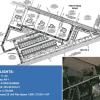The Cape May-Lewes Ferry has been crossing the Delaware Bay for 50 years, but the idea of a crossing dates back to the 19th century.
Several failed attempts – including an entrepreneur who planned to use experimental concrete ships – occurred over the years that eventually led to the formation of the Delaware River and Bay Authority in 1962.
Meanwhile, ferries crossing Chesapeake Bay had been a way of life for decades on the west side of the Delmarva Peninsula. But it would take a two-state effort to smooth the waters for the Cape May-Lewes Ferry and its first crossings, June 30 and July 1, 1964.
Ferry has been conduit for tourism
It's hard to imagine the transformation that Lewes has undergone over the past 50 years, and there is no doubt the ferry has played a role, said Mike DiPaolo, executive director of the Lewes Historical Society.
Tourism – the mainstay of Lewes today – was not on town officials' radar 50 years ago, he said. “They were hoping the ferry would be the vehicle to bring industry back to Lewes because Lewes was a working town,” he said.
Five decades ago, all of the special events that celebrate Lewes' significant history did not exist.
The huge fish factories along the bay in Lewes had either closed down or were in the process of closing down. Across the bay, Cape May had fallen on hard times, DiPaolo said, and was being upstaged by other shoreline towns.
DiPaolo said in 1964 the National Historic Preservation Act was passed. It didn't take long for residents on both sides of the bay to catch on to the importance of preservation and heritage tourism. The Lewes Historical Society formed about the same time.
DiPaolo said the transformation from blue collar to tourist town in Lewes took place over 15 years. “In the mid- to late-1970s there was a change in the thought process and people started to think about tourism,” he said. “The ferry was a useful bridge from the 1960s and 1970s to where we are today. It's amplified tourism efforts into focus.”
Many visitors to Lewes come via the ferry, said Betsy Reamer, executive director of the Lewes Chamber of Commerce. “All businesses benefit from the ferry,” she said, adding that the biggest trend is the number of foot passengers who take advantage of shuttles to Lewes, the outlets and Rehoboth Beach.
Today, the ferry offers several packages for travel including shuttle service to Cape May Zoo and guided tours of historic places in Cape May and Lewes. For people who walk on the ferry, shuttle service is provided into town. A bicycle package is also available to accommodate a growing number of cyclists who are taking advantage of trails on both sides of the bay.
In celebration of 50 years
Officials and residents gathered in Cape May June 28 and in Lewes June 29 to celebrate the 50th anniversary. In Lewes, the day included a classic car show, entertainment, games and an outdoor screening of the WHYY documentary “Billion Mile Journey.”
DRBA officials unveiled memorial pavers and buried a time capsule near the front door of the Lewes terminal.
The day ended with fireworks shot off from the Cape Henlopen State Park fishing pier. The park – which is also celebrating its 50th anniversary this year – and DRBA collaborated on the fireworks show.
During the event, Gov. Jack Markell touted the importance of the ferry, calling it the best boat ride in America.
First crossing hits a snag
Extensive celebrations on both sides of the bay were the order of the day 50 years ago leading up to the maiden voyage in the summer of 1964. Inaugural “Hands Across the Bay” ferry crossings were made to raise funds for community celebrations and parades. Celebrations included jet-fighter flyovers, sky divers, receptions and dinners and concerts.
Thousands of private boats escorted the first ferry to cross the bay. Power boat and sailboat races also coincided with first-week activities.
Formal dedication ceremonies occurred on June 30 in Lewes and Cape May. Hundreds of officials paid the $10 fare to be aboard the history-making first crossing of the bay with vessels leaving from both ports for dedication ceremonies. Others purchased a historical golden ticket for $3.50.
Ironically, during one of two ceremonial crossings that day, the ferry had its first accident. As the SS Cape May approached the Lewes dock, one of the ferry's two propellers hooked into a steel cable, which wrapped around the shaft making it inoperable.
New Jersey passengers aboard the SS Cape May disembarked to take part in the Lewes ceremony learning they were stranded in Delaware. The second ferry, SS Cape Henlopen, came to the rescue later in the day to take New Jersey passengers home.
“An embarrassing start for sure the day before the official opening to the public,” notes the ferry website.
A little known fact in ferry history is that the actual first crossing between the twin capes took place two years earlier in October 1962, according to Jim Salmon, DRBA public information officer. He said dignitaries from both states made the trip to celebrate the signing of the compact to create the DRBA.
“They wanted to prove it could be done,” Salmon said. That short cruise was made aboard the SS Pocahontas, on loan from the Virginia Ferry Corp., a ship that would later became the SS Delaware in the Cape May-Lewes Ferry fleet.
BY THE NUMBERS
17 miles across Delaware Bay
80-minute ride
14 million vehicles, 43 million passengers over 50 years
1 billion miles covered
First public crossing includes 8 vehicles and 15 passengers
Today the ferry operates four vessels
KEY DATES
1953: New Jersey legislation authorizes construction of ferry; Delaware does not
1962: Delaware River and Bay Authority established by both states and U.S. Congress; in
October, officials from both states take cruise across the bay to commemorate the event
April 1963: DRBA resolves to build Cape May-Lewes Ferry and new Delaware Memorial Bridge
February 1964: Engineering report concluded on plans for terminals, access roads, dredging, bulk heading and a Lewes breakwater
June 1963: $106 million financing plan for both projects with $12.7 million going to ferry system
April 1964: DRBA purchases four ferry vessels from Chesapeake Bay and Tunnel District for $3.3 million
June 30, 1964: Two ceremonial crossings occur
July 1, 1964: Ferry is open to public
























































